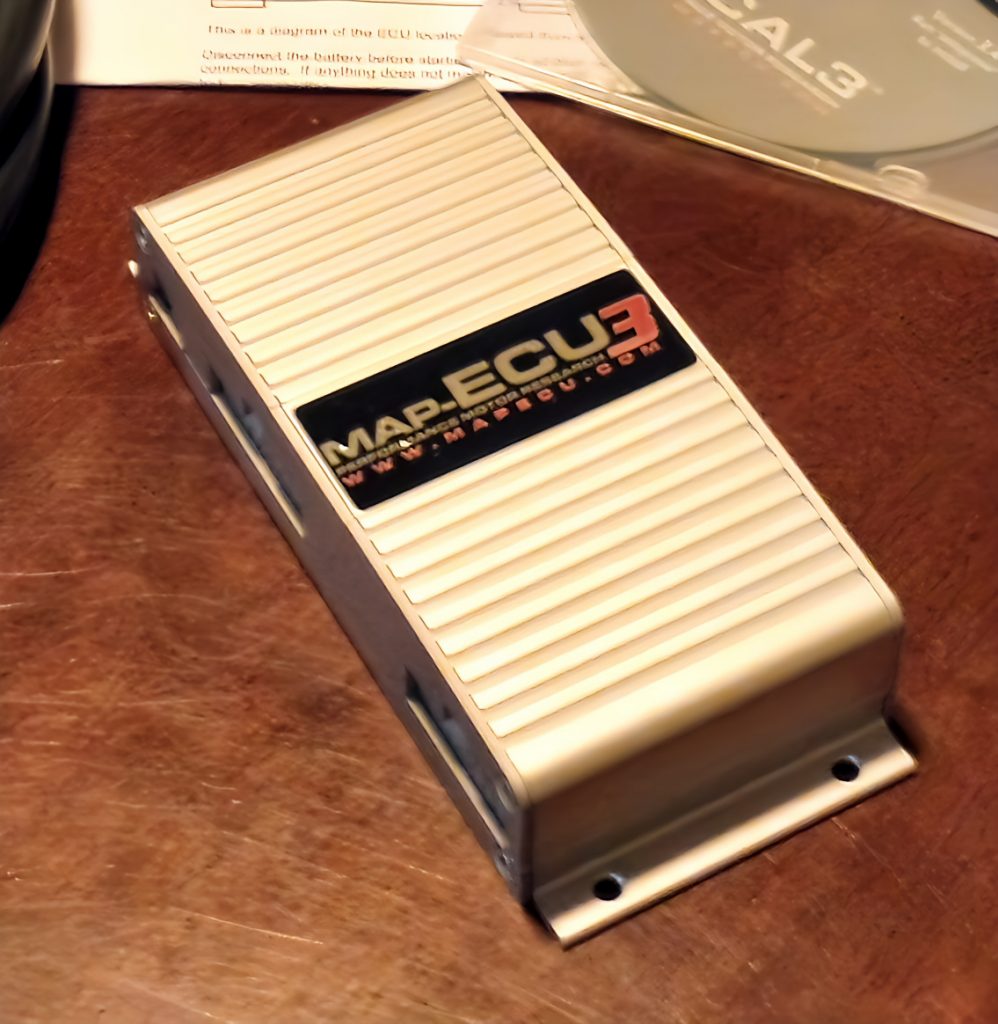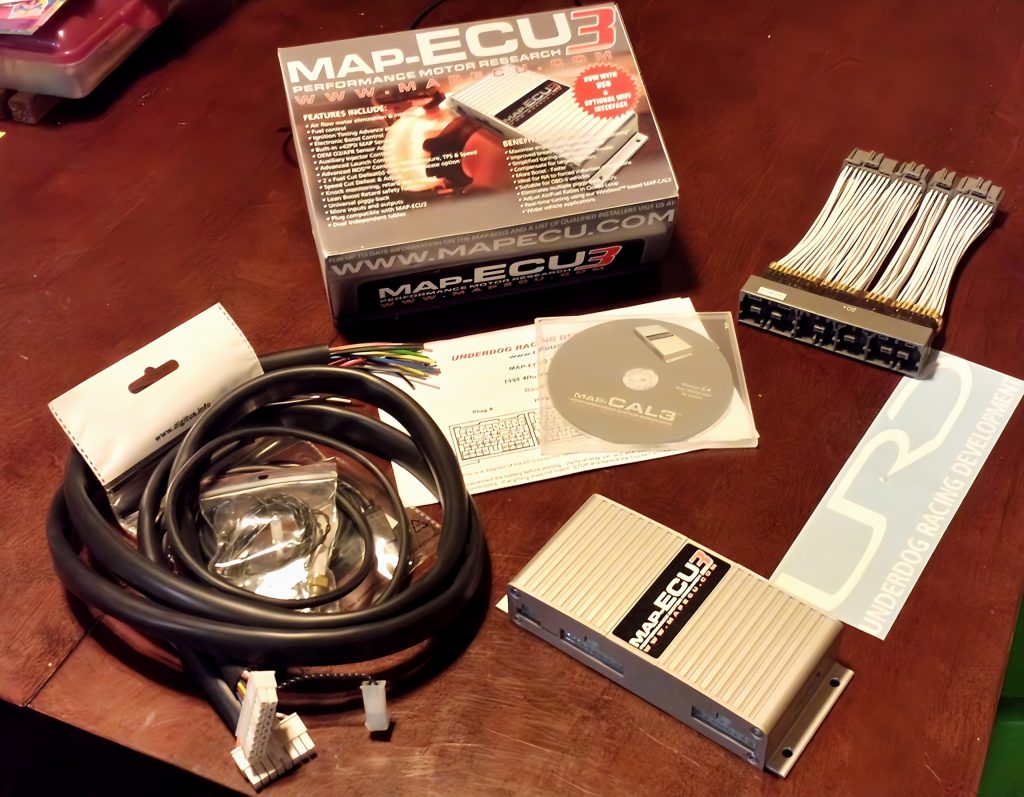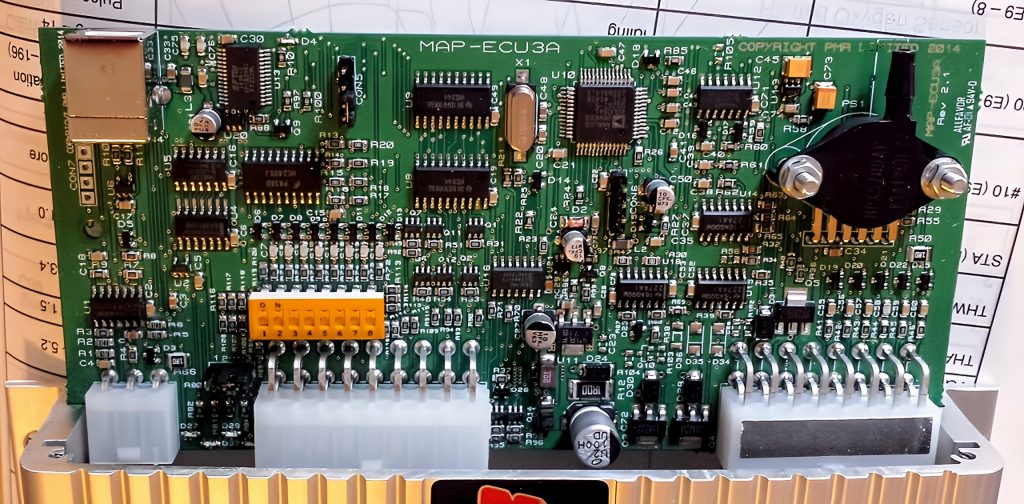

Introduction
Released around 2013, the MAP-ECU3 is the third and final generation of the MAP-ECU line of piggyback engine control units (ECUs). Primarily designed for performance tuning applications, it operates by intercepting and modifying the signals sent between a vehicle’s factory Electronic Control Unit (ECU) and its associated sensors. This method allows for targeted adjustments to fuel delivery and ignition timing, alongside incorporating features for enhanced engine management, such as electronic boost control and auxiliary injector support.
The MAP-ECU3 represents an incremental advancement over earlier the generation MAP-ECU 2. It expands the range of tuning capability, adds support for flex-fuel tuning, and adds a USB interface to facilitate real-time device configuration and datalogging functionality.
Historical Pricing Information
Pricing (circa 2015):
- MAP-ECU 3 kit (USB connectivity only): $695
- MAP-ECU 3 kit (with WiFi connectivity): $849
Technical Specifications

Product Overview
The MAP-ECU3 (Manifold Absolute Pressure Electronic Control Unit) is a high-performance piggyback ECU designed to eliminate restrictive airflow meters and enable Speed Density (MAP) tuning for modern vehicles. It supports forced induction and flex-fuel applications, offering extensive tuning flexibility with various configurable modes, electronic boost control, and flex-fuel compensation. The unit integrates seamlessly with most OEM ECUs to optimize performance without replacing the factory ECU.
Key Features
- Flexible Tuning Modes: Offers sixteen different elimination and intercept modes for Mass Air Flow (MAF) and Karman Vortex Frequency (KVF) meters, including MAF Elimination, MAP Replacement, and TPS Y-axis modes.
- RPM and Pressure Mapping: The fuel table supports mapping up to 10,000 RPM and +42 PSI, with 494 zones for fuel adjustments and 380 zones for ignition timing control.
- Electronic Boost Control (EBC): Includes internal and external wastegate control modes with fast spool support and closed-loop pressure adjustment for stable boost levels.
- Ignition Timing Adjustment: Allows timing adjustment by up to +/-30 degrees in 1-degree increments.
- Self-Learn Capability: The MAPECU3 can self-learn baseline fuel settings, streamlining the setup process.
- Auxiliary Injector Control: Supports up to six high-impedance injectors, providing additional fueling for high-performance applications.
- Flex Fuel Support: Incorporates real-time ethanol content adjustments and compensation tables for fuel and timing, compatible with GM Flex Fuel sensors.
- Multiple Table Storage: Holds two independent maps for fuel, timing, and boost control, selectable by a configurable input.
Specifications
- Input Voltage: 10-16 VDC, protected against polarity and over-voltage.
- PC Communication: USB 2.0 connection for real-time configuration and data logging.
- Pressure Sensor: Built-in 42 PSI absolute pressure sensor, with optional external MAP sensor support.
- Switched Outputs: Three 4A outputs for features like NOS activation, pressure switch, and auxiliary injectors.
- Fuel Table Resolution: 494 zones, mapped by RPM and MAP for precise control.
- Igniter Configuration: Eight independent igniter inputs/outputs supporting a range of configurations from 3-cylinder to V10 engines.
- Additional Inputs: TPS, IAT, CLT, EGT, and wideband AFR sensors for comprehensive engine monitoring.
Supported Components
- OEM Compatibility: Compatible with a wide range of OEM ECUs that support MAF and KVF sensors, with optional adapters for 10V MAF systems.
- Optional WiFi Module: Allows wireless connectivity for remote tuning.
Advanced Features
- Electronic Boost Control (EBC): Manages boost pressure with configurable sensitivity, gain, and target duty cycles for both internal and external wastegates.
- Lean Boost Retard: Adjusts ignition timing to prevent lean conditions under boost, ensuring safe AFR during high-load operation.
- Knock Retard: Integrated knock detection with timing retard for enhanced safety, compatible with recommended external knock sensor modules.
- RPM and Speed Cut Defeat: Controls frequency-based speed limitations, allowing adjustments for altered wheel/tire sizes or performance modifications.
- Enhanced Compensation Tables: Provides 2D compensation tables for IAT, barometric, and CLT-based adjustments for accurate fuel management in varied conditions.
Installation & Configuration
The MAP-ECU3 connects to a PC via USB and utilizes the MAPCAL3 software for configuration. Users can select from multiple modes based on specific vehicle requirements, including options for forced induction and naturally aspirated applications. Installation involves connecting sensors and configuring parameters within MAPCAL3 to suit the vehicle’s setup.
MAP-ECU3 Manuals
| Title | Description | Actions |
|---|---|---|
| MAP-ECU3 USB Driver Install Guide – Windows Vista | Install guide for MAP-ECU3 USB Driver, for Windows Vista. Released by Performance motor research LTD. | Download |
| MAP-ECU3 USB Driver Install Guide – Windows XP | Install guide for MAP-ECU3 USB Driver, for Windows XP. Released by Performance motor research LTD. | Download |
| MAP-ECU3 USB Driver Install Guide – Windows 7 | Install guide for MAP-ECU3 USB Driver, for Windows 7. Released by Performance motor research LTD. | Download |
| MAP-ECU3 Wifi Installation Guide – Supplement | Installation guide supplement for MAP-ECU3 Wifi Module, released by Performance motor research LTD. | Download |
| MAP-ECU3 Wifi Module Installation Guide | Install manual for MAP-ECU3 Wifi Module, released by Performance motor research LTD. | Download |
| MAP-ECU3 Wifi Connection guide – Win7 | Windows 7 Wifi setup manual for MAP-ECU3w/ WiFi Option, released by Performance motor research LTD. | Download |
| MAP-ECU3 Quick Start Guide | Quick start guide for MAP-ECU3 piggyback ECU released by Performance motor research LTD. | Download |
| MAP-CAL3 Manual | User Manual for MAP-CAL3 software released by Performance motor research LTD. | Download |
| MAP-ECU3 Manual | User Manual for MAP-ECU3 Piggyback ECU released by Performance motor research LTD. | Download |
